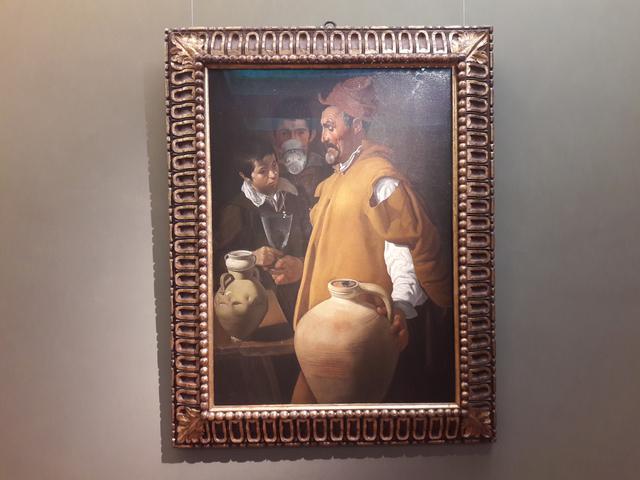The water seller of Seville

The Waterseller of Seville is the title of three paintings by the Spanish artist Diego Velázquez, dating from 1618-1622. The original version was painted by Velázquez when he was a teenager or in his early twenties. Looking at this painting, there is an older man, a child, and a viewer in the background. The old man is giving the boy a glass of water, but they never look at each other or make eye contact with the viewer.
According to José Guidol, Velázquez's The Water Seller of Seville was painted shortly before moving to Madrid. Guidol also classified this painting as a still life, due to the depiction of drinks. Art historians generally compare this painting to still lifes that were painted during the 17th century in Spain because this painting is very simple with a limited range of colors and Velázquez was working with stationary objects. This painting is done in a realistic style with a limited color palette, another characteristic of the still life genre. According to Jon Moffitt, this piece was not a commissioned work.
The subject of the painting is the water seller, a common occupation for the lower classes in Velázquez's Seville. The jars and vials are reminiscent of still life paintings. The vendor has two customers: a boy, possibly painted in the same pattern as the one used for the children in The Lunch and Old Woman Cooking Eggs, and a young man in the shadows in the background, (time has faded him a bit; he is lighter in the Uffizi version).
In the foreground sit the vendor's gigantic water pots, glistening with water splashes. So large and rounded, they almost come out of the painting into the observer's space. The seller gives the child a glass of freshly poured water. In it is a fig, a perfumer meant to make the water taste fresher (something still done in Seville today).
It is not known for certain, but it is assumed that the painting was done inside or near a tavern. Lighting enters the scene from the left and draws attention to the boy and the water droplets in the pot of water. This demonstrates the detailed work of Velázquez's paintings.
The calm and peaceful scene, a quality typical of his genre scenes and, indeed, much of Velázquez's work, is notable for the depiction of the salesman. His thoughtful face, battered by direct exposure to sunlight and deeply marked by age wrinkles, speaks of long years of experience. His short, shaved hair and plain old clothes give him the appearance of a monk, saint, or eccentric philosopher. The old man does not look at the boy or the other man in the shadows and does not make eye contact with the audience. The young man is the same. He doesn't make eye contact with the old man, and turns his back to the other man. And the young man does not make eye contact with the audience.
According to Antonio Palomino, the old man in the painting was old and very sick. He had torn his clothes revealing some skin and on that skin, there were warts. Next to the old man is a child. The old man gives the boy a glass of water and the boy takes it without any form of recognition.
© Tourblink